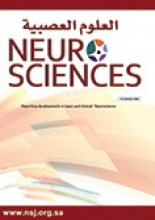Abstract
OBJECTIVE: To study the changes in the epidemiology of bacterial meningitis in the era of the Hemophilus influenzae (H. influenzae) type b vaccine and pneumoccous resistance.
METHODS: Retrospective study which included patients admitted to Hamad Medical Corporation, Doha, Qatar between January 1998 through to December 2000 with positive cerebrospinal fluid culture.
RESULTS: Thirty-seven patients with culture proven bacterial meningitis were described. Streptococcus pneumoniae (S. pneumoniae) and H. influenzae were the most common organisms, accounting for 30% and 24% of cases. Fever, neck stiffness, vomiting, and bulging fontanel were the most frequent presenting features. Fifty four percent of S. pneumoniae isolates were resistant to penicillin, and 22% of H. influenzae were resistant to ampicillin, but both were sensitive to ceftriaxone. No cases of Listeria monocytogenes meningitis were diagnosed. Morbidity was 32%, and mortality 5%. Poor outcome was associated with altered mental status on admission.
CONCLUSION: Bacterial meningitis is a serious illness in our community with significant morbidity and mortality. Streptococcus pneumoniae and H. influenzae are the most frequent pathogens causing meningitis in our community. As there is no bacterial resistance (S. pneumoniae and H. influenzae) reported against ceftrixone, we recommend ceftriaxone alone as empiric therapy for patients with no comorbid conditions presenting with community acquired bacterial meningitis. A continuous surveillance for changes in the microbiology of organisms causing bacterial meningitis or their sensitivity in our community is essential to update these recommendations.
- Copyright: © Neurosciences
Neurosciences is an Open Access journal and articles published are distributed under the terms of the Creative Commons Attribution-NonCommercial License (CC BY-NC). Readers may copy, distribute, and display the work for non-commercial purposes with the proper citation of the original work.






